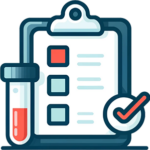Learn about the treatment options for invasive candidiasis.

TREATMENT OF INVASIVE CANDIDIASIS
Early treatment of invasive candidiasis is important for optimal outcomes. For this reason, therapy is often started as early as possible. The treatment may be classified as prophylaxis, empiric therapy, or pre-emptive/targeted therapy.
- Prophylaxis is often started in people who are at very high risk of invasive candidiasis. This includes certain patients with cancer, who have received transplants, who have had low blood counts, and certain patients in the intensive care unit. Providers will look at the number of risk factors (as outlined in the risk factor section) when deciding on whether to provide prophylaxis or not.
 Empiric therapy Sometimes, clinicians will treat empirically for invasive candidiasis, particularly in someone who has a lot of risk factors and has symptoms suggesting an infection, such as a fever. However, and wherever possible, it’s best to have a signal pointing to Candida when initiating therapy. This could be a positive Beta-D-glucan or PCR test. When therapy is guided by such testing, it’s called pre-emptive.
Empiric therapy Sometimes, clinicians will treat empirically for invasive candidiasis, particularly in someone who has a lot of risk factors and has symptoms suggesting an infection, such as a fever. However, and wherever possible, it’s best to have a signal pointing to Candida when initiating therapy. This could be a positive Beta-D-glucan or PCR test. When therapy is guided by such testing, it’s called pre-emptive.- Targeted therapy is therapy begun when the diagnostic testing has established an invasive candidiasis infection.
Treatment should be guided by the species and antifungal susceptibility testing. This is because certain species are more likely to be resistant at baseline. And therapy should be adjusted based on the findings of antifungal susceptibility. See the Science Sidebar on Candida Resistance.
TREATMENT OPTIONS
In this section, we go over the overall strategies as well as the drugs and other treatments used to manage invasive candidiasis. with a brief discussion of investigational therapies. Generally speaking, the echinocandin drug class is recommended as first-line empirical therapy, with fluconazole as an alternative in certain patients. The species of the organism and the resistance profile are important considerations.
It’s important to note that we provide generalizations about these therapies. Your provider will work with you to determine the best course of therapy for you. Your provider will consider the type of Candida you have, your medical history, and other factors such as kidney function, other medicines you are taking, and whether you are pregnant or breastfeeding, when selecting your therapy. For these specific considerations, please speak with your provider about how these factors impact the selection of your therapy.
While all of the drugs listed below are FDA-approved, some are not specifically approved to treat invasive candidiasis but are discussed in the Infectious Diseases Society of America Invasive Candidiasis Guidelines.
Finally, all of the data discussed are related to management of invasive candidiasis in adults. Information for pediatric patients is coming in a later module.
Echinocandins
Echinocandins are medications given by vein that inhibit the synthesis of part of the fungal cell wall. Echinocandins are the preferred drugs for treating invasive candidiasis.
Anidulafungin (Eraxis®)
HOW IT IS GIVEN: By vein (intravenous)
APPROVAL STATUS: Anidulafungin is FDA approved for treatment of invasive candidiasis.
HOW WELL IT WORKS: In a study comparing intravenous anidulafungin to intravenous fluconazole in patients with invasive candidiasis, intravenous anidulafungin was found to be non-inferior (no worse than) intravenous fluconazole. To read the paper about this study, click here.
COMMON SIDE EFFECTS: Low blood pressure, high blood pressure, shortness of breath, blood clots, blood electrolyte problems, liver function abnormalities, trouble sleeping
FINANCIAL RESOURCES: Pfizer RxPathways (866) 706-2400 or www.pfizerrxpathways.com.
Caspofungin (Cancidas®)
HOW IT IS GIVEN: By vein (intravenous)
APPROVAL STATUS: FDA approved for empiric therapy or treatment of invasive candidiasis
HOW WELL IT WORKS: Was found at least as effective as amphotericin B for the management of invasive candidiasis, particularly candidemia. To learn more about this study, go here.
COMMON SIDE EFFECTS: Not common: fever, complications in the vein where the drug was infused, nausea, vomiting, flushing, abnormalities in liver function, other laboratory test abnormalities
Micafungin (Mycamine®)
HOW IT’S GIVEN: By vein (intravenous)
APPROVAL STATUS: Micafungin is approved for the treatment of candidemia and several forms of deep-seated candidiasis. It is also approved for the prophylaxis of candidemia in patients receiving stem-cell transplantation.
HOW WELL IT WORKS: Was non-inferior to (at least as effective as) caspofugin in a study in patients with candidemia and other forms of invasive candidiasis. To learn more about this study go here.
COMMON SIDE EFFECTS: Diarrhea, agitation, headache, black stools, breathing problems, decreased urination, belly pain, tiredness, and bleeding or bruising
Rezafungin (Rezzayo®)
HOW IT IS GIVEN: By vein (intravenous) once weekly. Does not require a peripherally inserted central catheter (PICC Line).
APPROVAL STATUS: FDA approved in patients with candidemia and deep-seated candidiasis who have limited or no alternative options.
HOW WELL IT WORKS: In the RESTORE study, rezafungin was found not inferior to (at least as effective as) caspofungin in patients with candidemia and deep-seated candidiasis. To learn more about this study, see here.
COMMON SIDE EFFECTS: Flushing, warm sensations, hives, nausea, tightness in the chest (infusion reaction), sensitivity to the sun, and abnormal liver tests
PATIENT/FINANCIAL SUPPORT 1-866-REZZAYO or email REZZAYO@Assembia.com
Triazoles
Triazoles are named by their chemical structure. These drugs can interact with a lot of medications, so your provider will need to consider all the medications you are taking when starting azole therapy. Fluconazole, a type of triazole, is an alternative to an echinocandin for invasive candidiasis. The IDSA recommends that it be considered in select patients who are not critically ill and are not likely to have a fluconazole-resistant species. For more on resistant Candida, see the Science Sidebar.
FDA-approved
Fluconazole (DIFLUCAN®, other generic names)
HOW IT IS GIVEN: By vein (intravenous) or by mouth (tablet or oral suspension)
APPROVAL STATUS: FDA approved for treatment of invasive candidiasis and for prophylaxis against candidiasis in patients who are undergoing stem cell transplant or receiving chemotherapy or radiation therapy.
HOW WELL IT WORKS: Studies found that fluconazole was effective in certain patient groups as amphotericin B. However, the IDSA recommends that it only be considered as initial therapy in patients who are stable (not critically ill) and who are not likely to have a fluconazole-resistant species. Fluconazole also has a role as step-down therapy. For more on the studies of fluconazole for invasive candidiasis, see this review paper.
COMMON SIDE EFFECTS: Headache, nausea, belly pain, elevated liver enzymes, hair loss, loss of appetite, and nerve problems
Voriconazole (VFEND®)
HOW IT IS GIVEN: By vein (intravenously) or by mouth (tablets or oral suspension)
APPROVAL STATUS: FDA-approved for management of candidemia in patients without neutropenia
HOW WELL IT WORKS: In a study that compared voriconazole to amphotericin B followed by fluconazole in patients with candidemia without neutropenia, voriconazole was as effective as the amphotericin-B-plus-fluconazole regimen with fewer adverse events. To learn about this study. Please see the study here.
COMMONSIDE EFFECTS: Visual disturbances, fever, nausea, rash chills, headache, liver problems, heart rhythm problems, hallucinations. Long-term use: skin sensitivity and skin cancer. It also interacts with a number of other drugs.
Other Azoles
Isavuconazonium sulfate (CRESEMBA®)
HOW IT IS GIVEN: By vein (intravenous) and by mouth (capsules)
APPROVAL STATUS: Not FDA approved for invasive candidiasis
HOW WELL IT WORKS: Isavuconazonium sulfate was not found to be as effective as caspofungin followed by oral voriconazole in patients with invasive candidiasis. To learn more about this study, click here.
COMMON SIDE EFFECTS: Vomiting, nausea, diarrhea, liver problems, electrolyte problems, shortness of breath, swelling of arms or legs, back pain, and headache
FINANCIAL RESOURCES: CRESEMBA® Support Solutions. Call 1-800-477-6472 or visit the Support Solutions Page.
For patient information, see the Cresemba website.
Itraconazole (SPORANOX®, ONMEL®, suba-itraconazole, TOLSURA®)
HOW IT IS GIVEN: By mouth (capsule or oral solution) or by vein (intravenous)
APPROVAL STATUS: Not FDA approved for invasive candidiasis
HOW WELL IT WORKS: A small Japanese study found IV itraconazole was effective in managing invasive candidiasis in critical care and surgical patients. To read about this study, click here.
COMMON SIDE EFFECTS: Heart issues (IV), vomiting, diarrhea, abdominal pain, dizziness, drowsiness, rash, headache, blurred vision, liver damage, joint pain, heart problems, and swelling. It also has a number of drug-drug interactions.
Posaconazole (NOXAFIL®)
HOW IT IS GIVEN: By mouth (delayed-release tablets or an oral suspension) and by vein (intravenous)
APPROVAL STATUS: Not FDA approved for invasive candidiasis
HOW WELL IT WORKS: According to the IDSA guidelines, posaconazole has activity against Candida spp in vitro, but we don’t have enough clinical data to recommend it clinically.
COMMON SIDE EFFECTS: Gastrointestinal side effects (abdominal pain, constipation, diarrhea, nausea, vomiting), fever, swelling, low blood count, and liver enzyme elevations
FINANCIAL RESOURCES: NOXAFIL® Merck Patient Assistance Program. Call 800-727-5400 or visit www.merckhelps.com/NOXAFIL
Polyenes
These drugs are derivations of amphotericin B and are named for their chemical structure. At this time, these drugs must be given by vein, but a version that can be delivered by mouth is being studied. Amphotericin B type products are generally recommended when the infection is suspected to be caused by Candida that is resistant to azoles or echinocandins, if the patient can’t tolerate an azole, or if there is limited availability.
Amphotericin B Deoxycholate (conventional amphotericin, FUNGIZONE®), IV
HOW IT IS GIVEN: By vein (intravenous)
APPROVAL STATUS: FDA approved for invasive (systemic) candidiasis
HOW WELL IT WORKS: The IDSA recommends a lipid formulation of amphotericin B over conventional amphotericin B because the lipid forms are safer for the kidneys. To learn more, see the IDSA Candida guidelines.
SIDE EFFECTS: Fever, low blood pressure, upset stomach, loss of appetite, vomiting, diarrhea, anemia, kidney damage, and liver damage, allergic reaction
Amphotericin B lipid complex (ABLC, ABELCET®), IV
HOW IT IS GIVEN: By vein (intravenous)
APPROVAL STATUS: ABLC is indicated for the treatment of invasive fungal infections in patients who are not responding to (refractory to) or intolerant of conventional amphotericin B.
HOW WELL IT WORKS: In a study conducted in patients with varied invasive fungal infections, 67% of patients with invasive candidiasis experienced a complete or partial response to ABLC..
SIDE EFFECTS: Chills, fever, kidney problems, organ failure
FINANCIAL SUPPORT: Leadient Biosciences Patient Assistance Program: 800-490-3262
Liposomal amphotericin B (AmBisome®)
HOW IT IS GIVEN: By vein (intravenous)
APPROVAL STATUS: Approved for patients with Candida species refractory to amphotericin B deoxycholate or in patients in which kidney problems or unacceptable toxicity precludes the use of amphotericin B deoxycholate
HOW WELL IT WORKS: Liposomal amphotericin B was used successfully in patients with documented invasive candidiasis. Read more about this study.
COMMON SIDE EFFECTS: Rash, high blood sugar, electrolyte abnormalities, nausea, vomiting, low blood count, liver function abnormalities, chills, trouble sleeping, kidney function abnormalities, and shortness of breath
Antimetabolites
Antimetabolite drugs interfere with the energy production of cells. Flucytosine is an antimetabolite sometimes used as part of combination therapy for invasive candidiasis.
Flucytosine (Ancobon®)
HOW IT IS GIVEN: By mouth (capsules)
APPROVAL STATUS: FDA approved for invasive candidiasis in combination with amphotericin B
HOW WELL IT WORKS: In a study conducted in ICU patients, the combination of amphotericin B plus flucytosine was found similar to fluconazole in the management of pneumonia and sepsis but was more effective in the management of peritonitis and in pathogen eradication. To learn about this study, see here.
COMMON SIDE EFFECTS: Kidney problems, diarrhea, belly pain, low white blood cell and platelet counts, headache, altered taste, and itchiness
Clinical Trials and Investigational Agents

Clinical trials are research studies that test how well new treatment approaches work. They have an important place in your care as researchers strive to improve current invasive candidiasis treatments and search for new and better ones. Clinical trials are essential for learning about the management of invasive candidiasis.
Our most effective antifungal treatments would not be available without the clinical trial process. Unfortunately, many people with invasive candidiasis, or their loved ones, are unaware of the option for a clinical trial or are unsure about the value of participating.
Your goal is to find the best treatment available whenever you make a treatment decision. While there may be a good standard of care for you or your loved one—care that experts believe is appropriate for your specific diagnosis and treatment history—sometimes the current standard of care is not as effective as you and your healthcare team would like. Other times, the standard of care works for a time but then stops working. In still other instances, there is no standard of care for your situation. Participation in a clinical trial may be the best option for you.
The best time to search for clinical trials is every time you are faced with a treatment decision.
At the time this website was developed, there are some promising therapies in development for invasive candidiasis.
- Fosmanogepix/manogepix is a drug that uses a unique mechanism of action—this IV and oral drug interferes with an enzyme necessary for fungal adherence. Fosmanogepix has shown promising results in clinical trials for invasive candidiasis. It appears to have activity against drug-resistant Candida strains. For a summary of data, please read the following article as well as a more recent review.
- Ibrexafungerp belongs to a new class called the triterpenoid class, which has some similarities to echinocandins but with lower rates of cross-resistance. This drug interferes with the building of the fungal cell wall. Already FDA-approved for vulvovaginal candidiasis treatment and prevention, ibrexafungerp has shown benefit in an open-label study for invasive candidiasis. Ibrexafungerp is being evaluated in some larger invasive candidiasis studies.
- MAT2203 is an oral and non-toxic encochleated form of amphotericin B (CamB). Encochleation means that the drug is wrapped up in fat-based crystals and calcium that protect the drug from getting broken down within the GI tract but allows the drug to be taken up into the bloodstream and released in tissue because of calcium differences. At the time of this writing, MAT2203 has special FDA status as an investigational agent for management of invasive candidiasis among other fungal infections. To learn more about MAT2203 for invasive candidiasis, read this article.
Non-pharmacologic management
In order to provide the best possible care for patients with invasive candidiasis, providers need to consider management strategies beyond drugs. These include:
- Eye examination. Candida can affect the eye, causing a condition called Candida endophthalmitis. This condition can lead to vision loss. While there is some controversy over the role of examinations for this condition, a dilated eye exam is recommended by the IDSA.
- Source control. If there is a source of Candida within the body, it is important to control (and if possible) remove that source. A lot of times this can be a central venous catheter. Other times, if there is Candida in the intra-abdominal region, management such as drainage or surgical repair may be required, However, sometimes, the source cannot be controlled. See the SCIENCE SIDEBAR: Chronic Candidiasis on the Living with Invasive Candidiasis page to learn more about special situations where source control is difficult.
- If a person has Candida blood cultures that remain positive, fevers, or disease in the heart valve, an echocardiogram should be considered.
- Infectious-diseases consult. If your healthcare facility provides an infectious diseases consult, you are likely to have better outcomes. It’s worth asking for one!
Supportive Care: This includes measures to support the body’s functions, such as oxygen therapy, IV fluids, and treatment of any underlying conditions. In some cases, growth factors and other immune stimulation drugs can be considered to support neutrophil levels and fight the fungus.
Questions to ask your doctor about treatment for aspergillosis
- Have you diagnosed me (or my loved one) with invasive candidiasis? If so, where is it?
- Do you know the genus/species?
- Have you performed antifungal susceptibility testing? If not, is this something that you can obtain?
- What is my treatment plan, and will there be lasting effects when the plan is completed?
- Is there a possibility of recurrence?
- What drug are you going to use first?
- How do I take that medication?
- How long will I have to take that medication?
- Will this drug interact with any of my other medications? If it does, who is responsible for letting the provider prescribing those other medications know that I am starting or stopping the antifungal drug?
- How do you know if the medication is working?
- What are the side effects?
- Will I need additional laboratory tests to monitor me while I am on this medication?
- What is the cost of the medication? How will you help me with insurance?
- What will we do if it does not work?
- Will I need any other treatments? Will I “step down” to a less intense medication?
- Do you anticipate that I will leave the hospital on treatment? Will that be IV or oral? Will I have to have a special line to receive the medication?
- If I leave on IV medication, how often will I need to receive an infusion? Where will I go for that infusion?
- How will you control the source of the Candida?
- Is there a plan for an eye exam?
- Will you have to monitor my heart?
- Do you think I am an appropriate candidate for a clinical trial? Why or why not?
![]()

